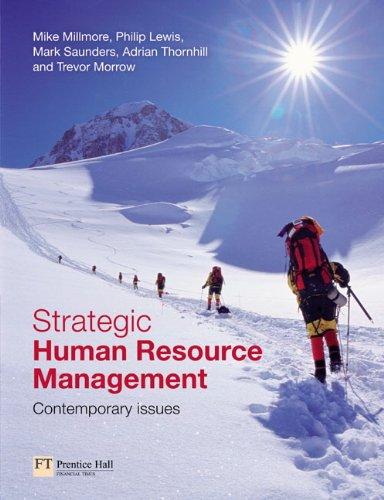The three cases outlined briefly below are drawn from the work of Salama et al. (2003) who
Question:
The three cases outlined briefly below are drawn from the work of Salama et al. (2003) who are investigating changes and opportunities presented by mergers and acquisitions (M&A) involving companies within related industries but which cross national boundaries. Such M&A frequently bring together people of diverse cultural backgrounds which create the potential either to enhance competitive advantage or to derail the M&A process and lead to its subsequent failure.
Their research provides an interesting counterpoint to the literature that emphasises how inappropriate integration strategies contribute to the high failure rate of M&A (see In Practice 7.1). In contrast, they report on three M&A success stories and have focused on researching the integration processes adopted to maximise potential synergies and minimise the potential negative effects of cultural differences between the organisations involved. Their central argument is that value-added outcomes arising from M&A are only likely to be realised if people from both organisations, and particularly their managers, have both the will and the ability to work collaboratively. They argue that ‘The key to integration is to obtain the participation of the people involved without compromising the strategic task’ (Salama et al., 2003: 313). This represents a critical agenda for HRP. One approach here would be to minimise the difficulties by establishing cultural compatibility as one important criterion for selecting possible M&A candidates. However, as exemplified in Chapter 6, a more realistic scenario is that cultural differences will exist and need to be managed. This scenario is a feature of all three cases and underpins their interest in integration strategies designed to encourage: tolerance of diversity; organisational learning;
knowledge transfer; and acculturation (culture change resulting from the interaction of different organisational cultures).
Deutsche Bank and Bankers Trust Deutsche Bank was in the process of strategic transformation from a German bank to a global organisation but lacked sufficient presence in the USA. It acquired Bankers Trust to address this and was particularly interested in the investment bank Alex Brown acquired by Bankers Trust two years earlier. The success of the acquisition has been largely attributed to the pre-integration period or ‘courting phase’ (Salama et al., 2003: 316). Here, during the due diligence period (the period of time between announcing and closing the M&A deal), an independent cultural assessment exercise was commissioned by Deutsche Bank senior management.
The cross-organisational perceptions of employees revealed that:...........
Questions
1. Compare and contrast the three outline cases from an HRP perspective. What are the main similarities and differences between them?
2. If you had been responsible for the HRP dimension of each of the three merger situations which do you think was handled most effectively and why?
3. If you had been responsible for the HRP dimension of each of the three merger situations what would you have done differently and why?
4. Critically evaluate the HRP process and practice evident in the three cases against the subject content of the chapter.
Step by Step Answer:

Strategic Human Resource Management Contemporary Issues
ISBN: 9780273681632
1st Edition
Authors: Mark N. K. Saunders; Mike Millmore; Philip Lewis; Adrian Thornhill; Trevor Morrow





